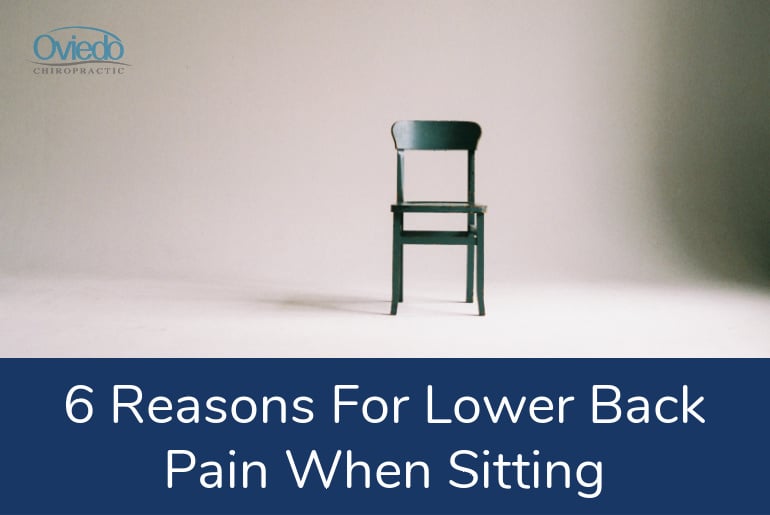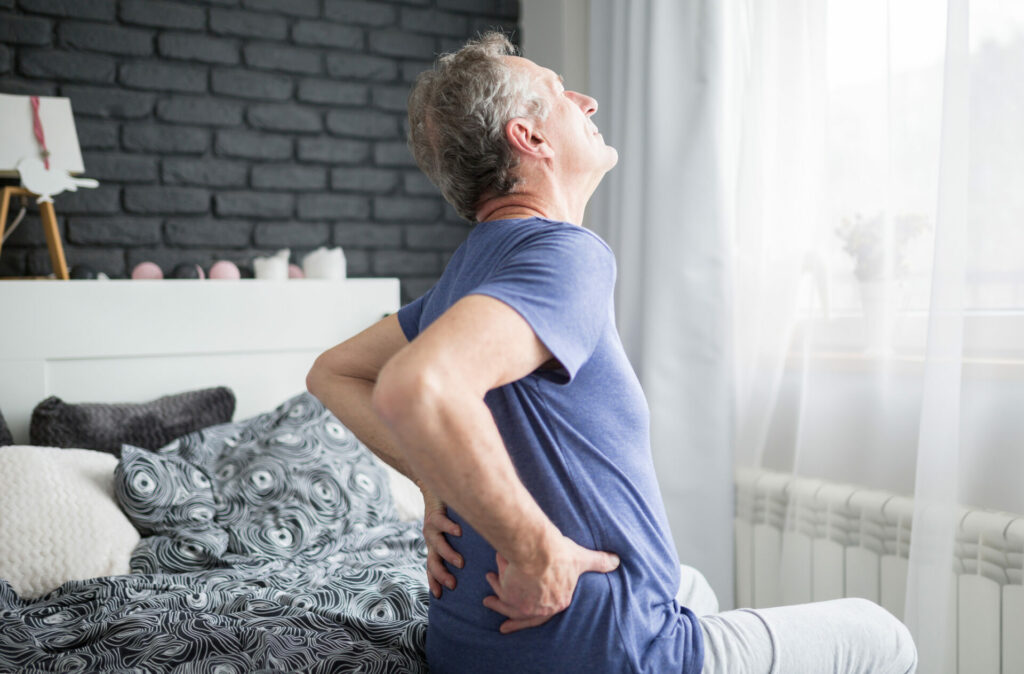Why Does My Back Hurt When I Stand Up? Unveiling the Causes
Ever wonder why you get that twinge, or worse, a jolt of back pain when standing up from sitting? You’re not alone. Several factors can be at play, making it important to understand what’s happening in your body. Think of your back as a complex machine, and prolonged sitting can throw a wrench into the works. Let’s explore some common culprits that cause back pain when standing up from sitting.
Muscle stiffness is a primary suspect. When you’re sitting for extended periods, especially with poor posture, your back muscles can tighten up like a rubber band left out in the cold. This is especially true if you work a desk job. Suddenly asking those stiff muscles to support you as you stand can cause them to scream in protest. Disc issues can also contribute. The discs in your spine act as cushions between the vertebrae. Sitting can compress these discs, and standing up can put pressure on them, especially if there’s already a pre-existing issue like a herniated disc. Spinal stenosis, a narrowing of the spinal canal, is another potential cause. This narrowing can put pressure on the nerves in your back, leading to pain when you stand and the spine extends. Add to that poor posture – slouching or hunching over – and you’re essentially setting yourself up for back pain when standing up from sitting. Poor posture places uneven stress on the spine, leading to discomfort and potential long-term problems.
A sedentary lifestyle, where you spend most of your day sitting, only exacerbates these issues. The less you move, the weaker and stiffer your muscles become, making them more susceptible to pain when you do get up. Honestly, it’s a vicious cycle. So, what’s the bottom line? Aching back pain when standing up from sitting often stems from a combination of muscle stiffness, disc issues, spinal stenosis, poor posture, and a sedentary lifestyle. Given these potential causes, it’s important not to self-diagnose. If the pain is persistent or severe, seeing a doctor or physical therapist is crucial to determine the exact cause and develop an effective treatment plan. Remember, addressing the root cause is key to finding lasting relief from back pain when standing up from sitting.
How to Find Relief: Simple Stretches to Ease Back Pain After Sitting
Experiencing back pain when standing up from sitting? You’re not alone. Often, it’s due to stiffness built up from prolonged sitting. Fortunately, some simple stretches can make a world of difference. These aren’t about intense workouts; they’re about gentle movements that get your body moving and blood circulating again. We want to ease that back pain when standing up from sitting.
One of the most effective stretches is the cat-cow pose. Start on your hands and knees, arching your back like a cat, then gently dip your stomach towards the floor, lifting your head and tailbone. Repeat this several times, coordinating with your breath. Hamstring stretches are also beneficial. Sit on the floor with your legs extended and reach for your toes. If you can’t reach, that’s perfectly okay; just reach as far as you comfortably can. Remember, it’s about the stretch, not the reach. Also, try gentle lower back rotations. Lie on your back with your knees bent and gently rotate your knees from side to side, keeping your shoulders on the floor. These movements helps to alleviate back pain when standing up from sitting.
When performing any of these stretches, pay attention to your form. You know what? Good form is more important than how far you can stretch. Avoid any movements that cause sharp pain. These stretches are designed to provide relief and should be performed gently and mindfully. It’s also important to breathe deeply and evenly throughout each stretch, enhancing the relaxation and effectiveness of the movements. Consistency is key. Incorporating these stretches into your daily routine, even if it’s just for a few minutes each day, can significantly reduce that back pain when standing up from sitting and improve your overall back health. So, give these a try and see how much better you feel!
Ergonomics Matter: Creating a Back-Friendly Workspace
Is your workspace secretly sabotaging your back? It’s a question worth asking, especially if you experience back pain when standing up from sitting. Ergonomics, the science of fitting workplace conditions to the worker, plays a vital role in preventing and managing this type of pain. Think of your workspace as a tailored suit for your body. If it doesn’t fit right, you’ll feel the strain. When talking about back pain when standing up from sitting, we usually don’t think that the problem is in our seat.
So, how do you create a back-friendly haven? Start with your chair. Adjust the height so your feet are flat on the floor or supported by a footrest. Your knees should be at a 90-degree angle. The monitor should be at arm’s length, with the top of the screen at or slightly below eye level. This prevents you from craning your neck, a major contributor to back and neck pain. Your keyboard should be positioned so your elbows are bent at a 90-degree angle, and your wrists are straight. Consider a wrist rest to prevent strain. Remember the 20-20-20 rule: every 20 minutes, look at something 20 feet away for 20 seconds. And most importantly, move! Get up and walk around every 30 minutes to improve circulation and prevent stiffness. Ergonomics isn’t a one-time fix; it’s an ongoing process of adjusting your workspace to meet your needs and prevent back pain when standing up from sitting. It’s an investment in your long-term health and well-being. So, how about getting a new and more confortable chair?
Good posture is also very important. Imagine a string pulling you up from the crown of your head. Keep your shoulders back and down, and engage your core muscles. Avoid slouching, which puts excessive pressure on your spine. Many people underestimate how much their posture contributes to back pain when standing up from sitting. Regular breaks are crucial, so stand up, stretch, and walk around. Even a few minutes of movement can make a big difference. These simple changes can significantly reduce your risk of experiencing back pain when standing up from sitting. They’re not just about comfort; they’re about protecting your spine and maintaining your overall health.
When Is It More Than Just a Little Back Pain When Standing Up From Sitting? Recognizing Serious Symptoms
It’s common to experience a twinge of back pain when standing up from sitting, especially after a long period. But how do you know when it’s more than just a minor ache? It’s important to be aware of certain red flags that signal a need for medical evaluation. Ignoring these symptoms could lead to more serious complications down the road. So, what are these warning signs?
Severe pain is definitely a reason to seek help. We’re talking about pain that is so intense it interferes with your daily activities. Numbness or tingling in your legs or feet is another concerning symptom. It could indicate nerve compression. Weakness in your legs is also a red flag; if you find it difficult to stand or walk, it’s time to consult a doctor. Loss of bowel or bladder control is a serious symptom that requires immediate medical attention. And pain that radiates down your leg, often called sciatica, shouldn’t be ignored. This could be a sign of a herniated disc or other spinal issue. Remember, any persistent or worsening back pain warrants a visit to a healthcare professional. Trying to tough it out might seem like a good idea but could be the worst thing to do. Addressing back pain when standing up from sitting promptly is key to preventing long-term problems. Ignoring pain can lead to chronic issues and a decreased quality of life.
Don’t hesitate to consult with a doctor or physical therapist if you experience any of these symptoms. A proper diagnosis is crucial for effective treatment, and they can determine the underlying cause of your back pain and recommend the best course of action. They might suggest imaging tests like X-rays or MRIs to get a clearer picture of what’s happening in your spine. It’s always better to err on the side of caution when it comes to your health, especially when dealing with potential spinal issues. Think of it this way: would you ignore a warning light in your car? Probably not! Your body is just as important, so pay attention to the signals it’s sending you. Ignoring back pain when standing up from sitting is like ignoring that warning light. You’re just asking for bigger problems later on. So, listen to your body, and don’t hesitate to seek professional help when needed.
Strengthening Your Core: Exercises for Long-Term Back Support
What’s the secret weapon for fighting back pain when standing up from sitting? A strong core! Think of your core muscles as the unsung heroes of your spine. They’re not just about getting a six-pack; they’re about creating a natural corset that supports your back and prevents it from taking all the strain. When those core muscles are weak, your back has to work harder, making you more susceptible to that familiar ache when you stand. You know, that feeling like your back is screaming, “Help me!”
So, how do you build this amazing core strength? You can start with some simple exercises you can easily do at home. Planks are fantastic. Start on your forearms and toes, keeping your body in a straight line. Hold for 30 seconds, and gradually increase the time. Bridges are another winner. Lie on your back with your knees bent, and lift your hips off the floor, squeezing your glutes at the top. And then there are bird dog exercises. Get on your hands and knees, and extend one arm forward and the opposite leg backward, keeping your core engaged. Remember, it is very important to have proper form to avoid additional injuries and ensure you have better recovery from that back pain when standing up from sitting. Aim for slow, controlled movements rather than rushing through them.
It is vital to know, that building a strong core isn’t a quick fix, but it’s an investment in your long-term back health and can alleviate back pain when standing up from sitting. A stronger core helps maintain proper posture and reduces the stress on your spinal discs and joints. Over time, you’ll find that standing up becomes much less of an ordeal, and more of a natural, pain-free movement. Remember to listen to your body, and don’t push yourself too hard, especially when you are first starting out. Gradual progression is key, and before you know it, you will have better core and manage that back pain when standing up from sitting.
The Straight Story: How Posture Impacts Back Pain When Standing Up From Sitting
Good posture, what’s the big deal, right? Actually, it’s a huge deal when it comes to back pain when standing up from sitting. Think of your spine as the central support beam of a building. If that beam is crooked, everything else suffers. Poor posture puts extra stress on your back muscles, ligaments, and spinal discs, especially when transitioning from sitting to standing.
So, how do you know if your posture is off? A simple test: stand against a wall. Your head, upper back, and buttocks should touch the wall. If there’s a large gap between the wall and your lower back, or if you have to strain to get your head to touch, you might have some postural imbalances. But what can you do about it? Start by being mindful of your posture throughout the day. Whether you are sitting or standing, imagine a string pulling you up from the crown of your head. Keep your shoulders relaxed and back, and engage your core muscles. This isn’t about becoming a statue, it’s about finding a comfortable, sustainable alignment that supports your spine. You know what else helps? Strengthening those core muscles. They’re like the internal scaffolding that holds everything in place, and helps minimize back pain when standing up from sitting.
One common culprit is slouching. Honestly, we all do it, especially when we’re tired or engrossed in something. But slouching rounds your back, pushes your head forward, and puts a ton of strain on your lower back. To correct it, try this: sit tall with your feet flat on the floor. Gently squeeze your shoulder blades together as if you’re trying to hold a pencil between them. Hold for a few seconds, then release. Repeat this several times a day to retrain your muscles. Another thing to keep in mind is your head position. For every inch your head juts forward, it adds about 10 pounds of pressure on your neck and upper back. Keep your head aligned over your shoulders, like a bowling ball balanced on top of a stack of blocks. Posture isn’t just about aesthetics; it’s about spinal health. And spinal health is crucial for minimizing back pain when standing up from sitting and enjoying a pain-free life.
Beyond the Chair: Small Changes, Big Impact on Your Back
Okay, so you’re dealing with back pain when standing up from sitting – it’s a common complaint, and often it is not just about your chair. What about your life outside the office? Let’s talk lifestyle. The choices you make every day can play a huge role in how your back feels. You know what? Sometimes the simplest adjustments can make a world of difference.
First, let’s get physical. Regular exercise is key. We’re not talking about running a marathon (unless you want to!), but incorporating movement into your day. Think walks, swimming, yoga – anything that gets your body moving. Aim for at least 30 minutes of moderate-intensity exercise most days of the week. Maintaining a healthy weight also reduces the load on your spine. Extra weight, especially around your midsection, can put a strain on your back muscles and contribute to that nagging back pain when standing up from sitting. And honestly, it’s not just about vanity; it’s about taking care of your body’s foundation. If you smoke, quitting is one of the best things you can do for your overall health, including your back. Smoking reduces blood flow to the spine, which can slow healing and worsen pain. Also, back pain when standing up from sitting can be caused or aggravated by stress. Finding healthy ways to manage stress, such as meditation, deep breathing exercises, or spending time in nature, can help alleviate muscle tension and reduce pain. Finally, don’t underestimate the power of sleep. Aim for 7-9 hours of quality sleep each night. During sleep, your body repairs and rejuvenates itself, including your back muscles. A good mattress and proper sleep posture can also make a difference. Did you know that your sleep position affects the alignment of your spine?. So, choosing the right mattress and pillow could contribute to long-term spinal health.
Back pain when standing up from sitting is often multifactorial, so addressing lifestyle factors is often the best solution. Little things add up. By embracing these lifestyle adjustments, you’re not just treating back pain; you’re investing in your long-term well-being and ensuring a more comfortable, active life. Honestly, your back will thank you.
Exploring Treatment Options: From Over-the-Counter to Professional Care
So, you’re dealing with back pain when standing up from sitting? What can you actually do about it? Well, the good news is, there are several avenues to explore, depending on the severity and cause of your discomfort. Let’s walk through some options. Sometimes, simple solutions can provide significant relief, while other times, more specialized interventions become necessary to actually get rid of that recurring lower back pain when standing up from sitting.
First off, over-the-counter (OTC) pain relievers, like ibuprofen or naproxen, can help manage inflammation and pain. Topical creams or gels containing menthol or capsaicin can also provide localized relief. But you know, these are often temporary fixes, especially if the underlying issue causing the back pain when standing up from sitting isn’t addressed. For example, if your pain is caused by a specific muscle strain, some gentle stretching and OTC remedies might do the trick. If it’s related to something more complex, like a disc issue or spinal stenosis, you might need a more comprehensive approach. Physical therapy can be a game-changer here. A physical therapist can guide you through exercises to improve flexibility, strengthen your back and core muscles, and teach you proper posture. Chiropractic care is another avenue some people find helpful. Chiropractors focus on spinal manipulation to alleviate pain and improve function. In some cases, back pain when standing up from sitting could be caused by a misalignment in the spine.
In more severe cases, or when conservative treatments don’t provide relief, other options might be considered. These could include prescription pain medications, injections (like cortisone injections), or, as a last resort, surgery. Honestly, surgery is usually only considered when other treatments have failed and there’s a clear structural problem that needs to be addressed. Remember, the best course of action really depends on the individual, the underlying cause of their pain, and their overall health. Consulting with a healthcare professional is crucial for getting an accurate diagnosis and developing a personalized treatment plan to address that nagging back pain when standing up from sitting. A tailored plan will not only address the pain but also help prevent future episodes.




